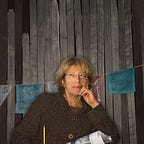Diebenkorn’s Daughter
Last night at the Hillside Club in Berkeley I heard Gretchen Diebenkorn Grant, daughter of the artist Richard Diebenkorn, speak about her father’s art and what it was like growing up in the house of a man who made art 365 days and often nights a year.
Gretchen grew up in Berkeley in the early sixties and sometimes wished she lived in a house like those of her friends, which had matching furniture, and curtains rather than bare windows, and didn’t use bedspreads from India as tablecloths. Her father didn’t care about material possessions and either made his own furniture for his studio or picked up discarded chairs and tables from the roadside.
She compared some of his work to that of Matisse, an artist he admired, but apart from similar color and composition choices in several of his works that are now on display at SFMOMA in an exhibit comparing the two artists, the daughter didn’t have much to add except to say both painters ignored world politics as content for their art. (That exhibit seemed to me a contrivance of crowd-pleasing curators that diminished rather than articulated the painters’ respective merits.)
The daughter revealed that Diebenkorn painted from his mind. It turns out the vertiginous, colorful landscapes he painted in his Ocean Park, Santa Monica years were completely imaginary. And he didn’t use photographs or preliminary sketches: he just attacked the canvas, or in many cases, the empty backs of posters since he used any paper surface he could find. He painted directly from his mind to paper, much like a conductor’s wand evokes music from an orchestra.
Most poignant were the match boxes Diebenkorn painted meticulously for his granddaughter’s dollhouse and the Easter egg adorned with a spade — a favorite shape of the artist — created for his grandson. He also sketched a fanciful dragon but tired of filling in the creature’s scales so asked his son-in-law, Richard Grant, to complete the rest and give him co-artist credits.
Grant and his wife spent more than 22 years and a fortune — some of it earned from the sale of Diebenkorns given to them by his wife, Phyllis — to create a four-volume catalog raisonee of all the artist’s paintings, recently published by Yale University Press. They spent two weeks and 12-hour days at a specialty color press in Verona, Italy, to insure the color quality of the paintings in the catalog, and now they are embarked on a similar catalog for all the artist’s prints.
The Diebenkorn daughter, a former actress, is an artist in her own right. With a painter’s eye, she captures the processes of her father’s artistic genius as well as the tenderness between a loving father and child.
